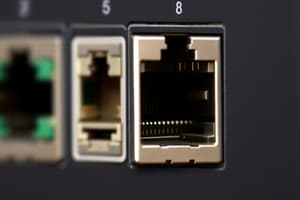Podcast
Questions and Answers
What happens if you do not subnet a Class A, B, or C network?
What happens if you do not subnet a Class A, B, or C network?
- You can assign multiple IP addresses to each device.
- You are limited to using only one network. (correct)
- You can create unique network IDs for each node.
- You can use multiple networks for different purposes.
How many subnets can be created by extending the mask of a Class C network to 255.255.255.224?
How many subnets can be created by extending the mask of a Class C network to 255.255.255.224?
- 16 subnets
- 8 subnets (correct)
- 4 subnets
- 6 subnets
What is the maximum number of host addresses available for a subnet with the mask 255.255.255.224?
What is the maximum number of host addresses available for a subnet with the mask 255.255.255.224?
- 32 usable addresses out of 34 total addresses
- 31 usable addresses out of 32 total addresses
- 30 usable addresses out of 32 total addresses (correct)
- 16 usable addresses out of 18 total addresses
Which of the following IP addresses would be part of the first created subnet 192.168.5.0 255.255.255.224?
Which of the following IP addresses would be part of the first created subnet 192.168.5.0 255.255.255.224?
What is indicated by the 'host ID' bits in an IP address when subnetting?
What is indicated by the 'host ID' bits in an IP address when subnetting?
What is the range of public IP addresses for Class B?
What is the range of public IP addresses for Class B?
Which of the following describes Class D IP addresses?
Which of the following describes Class D IP addresses?
What is the subnet mask for a Class C IP address?
What is the subnet mask for a Class C IP address?
How many hosts can be accommodated in a Class C network?
How many hosts can be accommodated in a Class C network?
What is the first octet range for Class E IP addresses?
What is the first octet range for Class E IP addresses?
Which IP range is designated for private Class B addresses?
Which IP range is designated for private Class B addresses?
What is the primary use of Class A addresses?
What is the primary use of Class A addresses?
What does subnetting accomplish in IP networking?
What does subnetting accomplish in IP networking?
What is the primary purpose of unicast addressing in networking?
What is the primary purpose of unicast addressing in networking?
Which IP address range is defined for multicast addressing?
Which IP address range is defined for multicast addressing?
How does anycast addressing deliver data packets on a network?
How does anycast addressing deliver data packets on a network?
Which class of IP addresses allows for the largest number of hosts per network?
Which class of IP addresses allows for the largest number of hosts per network?
What is the range of private IP addresses for Class A?
What is the range of private IP addresses for Class A?
How many networks can Class B addresses support?
How many networks can Class B addresses support?
Which of the following best describes multicast addressing?
Which of the following best describes multicast addressing?
Flashcards
Subnet
Subnet
Dividing a large network (like a Class A, B, or C network) into smaller, interconnected networks (subnetworks).
Subnet mask
Subnet mask
Specifies the portion of an IP address that identifies the network and subnetwork.
Subnetting
Subnetting
The process of dividing a network into smaller subnetworks
Network ID
Network ID
Signup and view all the flashcards
Host ID
Host ID
Signup and view all the flashcards
Unicast Addressing
Unicast Addressing
Signup and view all the flashcards
Multicast Addressing
Multicast Addressing
Signup and view all the flashcards
Anycast Addressing
Anycast Addressing
Signup and view all the flashcards
Class A IP Address
Class A IP Address
Signup and view all the flashcards
Class A Private IP Range
Class A Private IP Range
Signup and view all the flashcards
Class A Public IP Range
Class A Public IP Range
Signup and view all the flashcards
Broadcast IP Address
Broadcast IP Address
Signup and view all the flashcards
Multicast IP address range
Multicast IP address range
Signup and view all the flashcards
Class B IP Address Range
Class B IP Address Range
Signup and view all the flashcards
Class B Network ID
Class B Network ID
Signup and view all the flashcards
Class C Host ID bits
Class C Host ID bits
Signup and view all the flashcards
Class C IP Range
Class C IP Range
Signup and view all the flashcards
Study Notes
Logical Addressing
- IP addresses and MAC addresses are crucial for data communication
- Assume two networks with devices A, B, C in one and X, Y, Z in the other
- To send data from A to Y, the IP address of Y is first determined
- IP addresses are logical and may change when moving to another network
- MAC addresses are physical and remain constant across networks
- IP addresses are assigned by ISPs mathematically (not random)
- The Internet Assigned Numbers Authority (IANA) manages IP address assignment
- IP Version 4 (IPv4) uses a 32-bit address, four numbers (octets) separated by dots (e.g., 172.166.3.28)
- IP Version 6 (IPv6) is the newer version, using 128 bits, expressed in hexadecimal (e.g., 3221:1cd7:74b6:6da7:0000:0000:7349:6472)
- MAC addresses (Media Access Control) uniquely identify network interface controllers (NICs)
- MAC addresses are 48 bits long and not routed between networks, typically expressed in hexadecimal with colons (e.g., 2C:54:91:88:C9:E3)
IP Address Types
- Two main types of IP addresses (public and private)
- Public addresses are used for communication outside the local network (external IP address)
- Private addresses are used within the local network
- A static IP address remains constant, while a dynamic IP address changes over time
- Dynamic addresses are usually assigned by a DHCP (Dynamic Host Configuration Protocol) server
- Static addresses are assigned manually or through a configuration protocol and do not change
IP Address Structure
- IP addresses are composed of four numbers, each ranging from 0 to 255 (e.g., 192.158.1.38)
- The IP address has two parts: the network ID (e.g., 192.168.1) and host ID (e.g., 32)
- Each number in an IP address is an octet (byte)
IP Address Classes
- IP addresses are categorized into classes A, B, C, D, and E (different ranges/size for different purposes)
- Class A, B, and C addresses are commonly used on networks, while classes D and E are for specific use cases
- Different classes support varying numbers of networks and hosts
Subnetting
- Subnetting allows dividing a large network into smaller sub-networks
- It is done by adjusting the host ID portion of the IP address to increase the network ID
- This is done by modifying the subnet mask (e.g., 255.255.255.0) to allocate and manage multiple networks
Studying That Suits You
Use AI to generate personalized quizzes and flashcards to suit your learning preferences.




